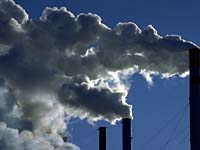

Air pollution comes in the form of carbon dioxide, ozone, hydrocarbons, carbon monoxide, particulates, nitrogen, and sulphur oxides. The damage from one form of air pollution, acid precipitation, can be studied in the classroom. (Recent studies suggest that acid precipitation is not the sole cause of decline, but one of the many airborne pollutants that are operating synergistically and contributing to forest die back.) |
Acid precipitation results when nitrogen and sulphur oxide emissions from coal-burning electrical generating plants, industrial boilers and large smelters, incinerators, and automobiles are caught up in prevailing winds and transformed into dilute solutions of sulphuric acid and nitric acid. Acid rain, fog, and snow are capable of being transported over long distances in the upper atmosphere and then deposited hundreds or thousands of kilometres away from the emission source. Precipitations ranging in pH from 3.5 - 4.5 commonly occur in Southern Ontario and Quebec and the Atlantic provinces. Occasional readings of less than pH 3.0 are also found. (On the pH scale: 1 is most acidic and 14 most alkaline or basic. Normal rain is 5.6. Distilled water has a pH of 7.) The problem is particularly acute on granite based soils of the Canadian Shield.
The problem of forest ecosystem decline is complex. In addition to the obvious effects on forest trees, air pollution will have broader impacts on the entire forest ecosystem. Generally speaking, understory species such as lichens, mosses, herbs, and shrubs are even more sensitive to air pollution than deciduous trees and conifers. This understory layer plays a vital role in maintaining water relationships within the ecosystem. Loss of ground cover could result in the drying out of the soil and the root systems of higher plants, including trees. The response of these understory species may, over the long term, be just as important as direct effects on the trees themselves.